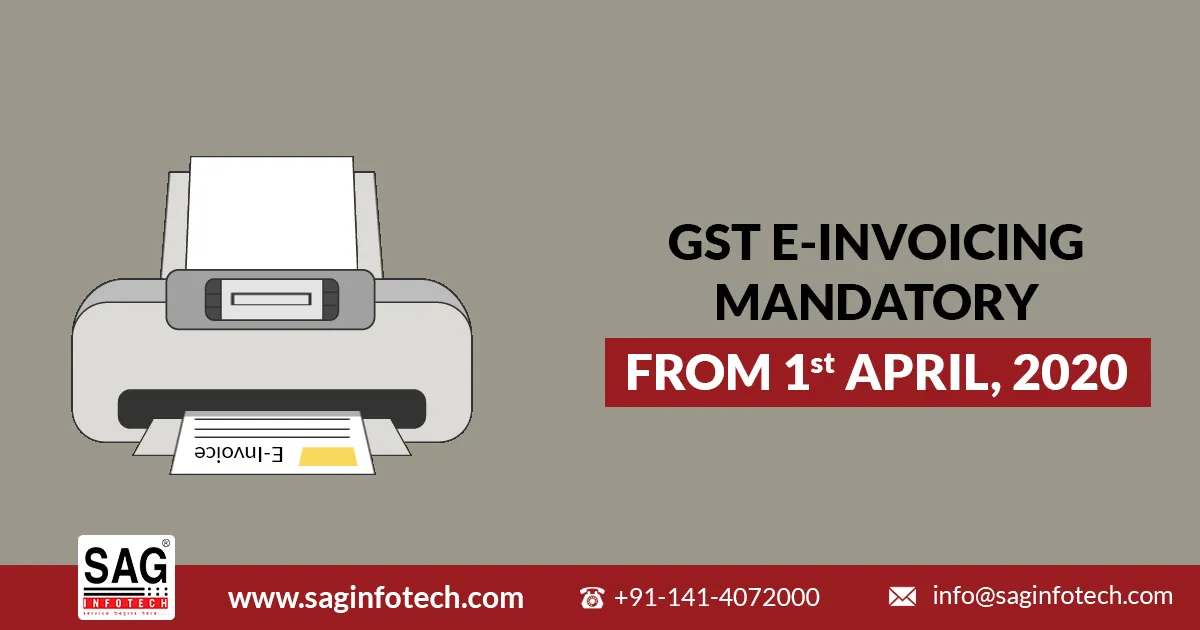Mandatory Implementation of GST E-Invoicing w.e.f April 1, 2020
Blog: NASSCOM Official Blog

The coming April month of 2020 will mark the mandatory beginning of the GST E-invoicing system in certain business categories. This necessity will bring along many benefits for banks and businesses, particularly for MSMEs.
Mandatory invoicing will let MSMEs avail bank loans easily and instantly. And also, the banks will now need not have to check a huge bundle of tangible documents as the authentication will completely rely on MSME’s rating based on their e-invoicing. Moreover, it will also simplify the GSTR filing for businesses by pre-populating the returns and lessening down the reconciliation issues.
For businesses with turnover below 100 Crore, e-invoicing would remain voluntary, however, it will be available for trial for such businesses from 1st April 2020.
The government has been preparing itself to implement the e-invoicing mechanism in a full-fledged way for the last 6 months as it wanted to commence ‘E-invoicing’ in a phased way for the generation of business to business (B2B) invoices on a voluntary basis.
The government concluded to mandate the e-invoicing from 1 st January 2020 and 1 st February 2020 for businesses with a turnover of INR 500 Crore or more and for the businesses having a turnover of INR 100 Crore or more, respectively. Both the dates are for the implementation of e-invoicing on voluntary as well as on the trial basis.
Ease of Filing – Government’s Aim
The government decided to introduce e-invoicing with an intent to simplify the filing of GST return system for the taxpayers. E-invoicing would allow the tax department to facilitate the businesses and taxpayers by pre-populating the returns which will also reduce the issues related to reconciliation. In a real sense, the Government aimed to move forth with technological advancements to facilitate the people by simplifying their lives and businesses with the use of technology.
Standard Format for Invoice
Apart from all the ease, e-invoicing will also bring standardization in the invoicing by following a particular format for the generation of e-invoices which will be readable by the systems other than that on which it was generated. This will also make the reporting of such invoices to a central system, possible.
The standard format will not affect the holders of the invoices, neither it would arise any trouble for the invoice generators as the new format will b adopted by all the accounting & taxation software, followed by a realignment of their data access and its retrieval in the approved format.
Process of E-invoicing
The taxpayer will hold the responsibility to generate the GST e-invoice and to communique the same to GST’s Invoice Registration Portal (IRP). After this, a unique Invoice Reference Number (IRN) will be generated by the portal, followed by digital signature on the e-invoice, generation of QR code which carries all the important specifications and restoration of e-invoice by the taxpayer who initially generated the document. The signed invoice will also be sent to the recipient of the document by the IRP on the email address given in the e-invoice.
Same personal accounting software/ERP or excel based tools etc will still be needed and used to generate the e-invoices by the taxpayers. E-invoice would not signify the generation of the invoice from the tax departments’ central portal. There would be a standard format for the generation of GST e-invoices to facilitate invoice sharing among different stakeholders.
Preparation at GSTN
GSTN has introduced eight billing & accounting software to facilitate the small taxpayers to get intoned with the GST e-invoice system easily. This accounting & billing software will be available for free for small taxpayers.
A small taxpayer who is currently not using any taxation and accounting software will also be able to make use of any of the software provided by GSTN for free. Such software will available for online use(cloud-based) as well as offline use (on the user’s computer system).
E-invoice Facilities for the Taxpayer
GST E-invoice will bring better facilities for the taxpayers. These services include:
- Generation of sales and purchase register (ANX-1 and ANX-2) from the data so that the returns (RET-1 etc.) can be kept ready to file as per the New Return mechanism. e-Invoice data can be used to generate e-Way Bill.
- Reduction in reporting in multiple formats like one reported in GSTR-1 and others in the e-way bill. Single time reporting in the B2B invoice data in the form.
- A considerable contraction in the verification process of Input Tax Credit. The data related to Input Tax Credit gets reported to the tax department and also to the recipient’s inward supply (purchase) register.
The post Mandatory Implementation of GST E-Invoicing w.e.f April 1, 2020 appeared first on NASSCOM Community |The Official Community of Indian IT Industry.
